May 20, 2025 | 05:57 GMT +7
May 20, 2025 | 05:57 GMT +7
Hotline: 0913.378.918
May 20, 2025 | 05:57 GMT +7
Hotline: 0913.378.918
According to Ms. Nguyen Thi Ngoc Lan, Deputy Director of Binh Dinh Animal Husbandry and Veterinary Sub-Department, flood levels will not be significant enough by the end of 2021 to wash away the pollution in the water source caused by shrimp farming activities the previous year. Moreover, the flood outlet is also blocked by works and roads, preventing water from flowing into Thi Nai lagoon and into the sea, so the polluted water source persists in the farming water source.
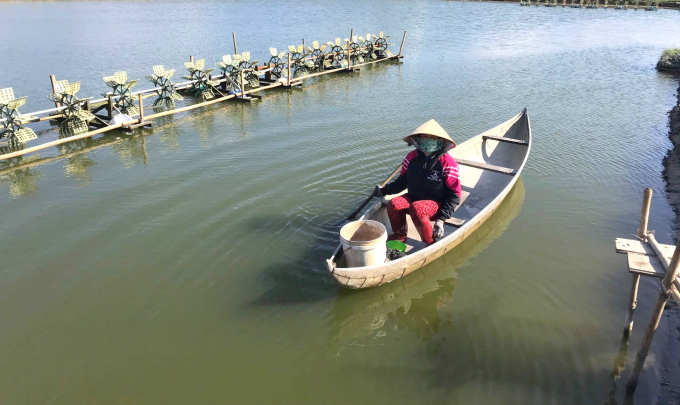
Shrimp farmers in Phuoc Son commune (Tuy Phuoc district, Binh Dinh) taking care of farmed shrimps. Photo: V.D.T.
Additionally, recent weather changes are also more erratic compared to previous years. The sunny, rainny, and cold weathers follow one another consecutively, causing a large amplitude of differences between day and night, exposing farmed shrimps to shock, which is also a condition for diseases on shrimps to develop. Therefore, shrimp diseases have occurred on a large scale in some localities in Binh Dinh.
Sine the beginning of the farming season, the total area of disease-affected ponds in the province has reached nearly 41 hectares. In Tuy Phuoc district, during the unseasonal rains at the end of March and the beginning of April, shrimp farmed on an area of nearly 40 hectares died due to environmental shock, mainly in Phuoc Thang, Phuoc Hoa, Phuoc Son, Phuoc Thuan and My Thanh communes (Phu My district).
In Tam Quan Bac ward (Hoai Nhon town), 1.18 hectares of ponds were infected with white spot disease. Shrimps farmed on an area of 0.56 hectares in Hoai My commune (Hoai Nhon town) and Nhon Hoi commune (Quy Nhon city) suffered from acute pancreatitis.
“Binh Dinh raised shrimp on an area of 1,728 hectares for the first crop of this year, down by 5.1% compared to the same period last year. More specifically, the farming area for black tiger shrimp was 1,266 hectares, down by 6.4% and the farming area for whiteleg shrimp was 462 hectares, down by 1.2%. In summary, the area of shrimps that died due to diseases accounted for 2.28% of the total shrimp farming area.
Environmental diseases in Tuy Phuoc and other districts also slowed and damaged many areas of shrimp farming. Reduced resistance in farmed ships, coupled with a declining environment, are favorable conditions for disease outbreaks on a large scale. According to forecasts, the weather will continue to have many complicated developments, which will be detrimental to farmed shrimp. Shrimp farmers need to fully grasp the solutions as guided by functional industry to prevent diseases for farmed shrimp”, said Ms. Nguyen Thi Ngoc Lan.
Since the beginning of the farming season, the Binh Dinh Department of Livestock and Veterinary Medicine has cooperated with other localities to collect 72 samples of shrimp, pond water to test and monitor common dangerous diseases, as well as set forth preventative solutions to reduce damage for shrimp farmers.
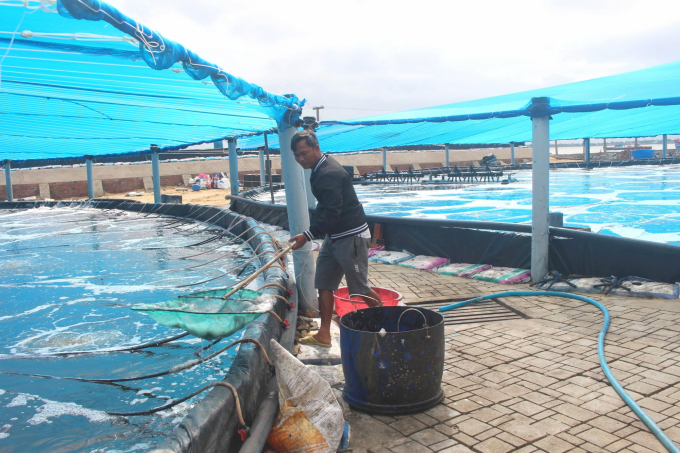
Shrimp farmers using tarpaulin-lined ponds need to regularly clean the pond bottom to reduce the amount of organic humus. Photo: V.D.T.
Shrimp farmers can promptly grasp information and proactively prevent diseases provided that Binh Dinh Department of Agriculture and Rural Development requests the local government to direct the functional sector and guide shrimp farmers on strengthening measures to prevent disease in farmed shrimp. Shrimp farmers in the area are requested to actively monitor weather developments, closely inspect the pond environment and water parameters daily to make timely adjustments.
Pond owners need to actively treat water sources, add water to the ponds when necessary, and overcome water stratification caused by heavy rains during the process of farming. Regarding traditional ponds, farmers need to periodically disinfect pond water to kill pathogens, as well as reduce algae growth for ponds with high algae density, creating a clean and stable environment for shrimps to develop. They should also use probiotics and minerals to treat water and pond bottoms, create beneficial bacteria, inhibit and prevent harmful bacteria from growing.
For ponds lined with tarpaulin, it is necessary to clean the pond bottom to reduce the amount of organic humus in the pond, limiting the production of toxic gases affecting shrimps. Farmers need to strictly control the amount of feed through screening, or bottom diving, assess the survival rate to estimate the appropriate amount of feed and avoid backlog that can cause pollution in the pond environment, avoid feeding when it rains heavily or the temperature rises above 32 degrees Celsius, increase the amount of food when the temperature is cooler.
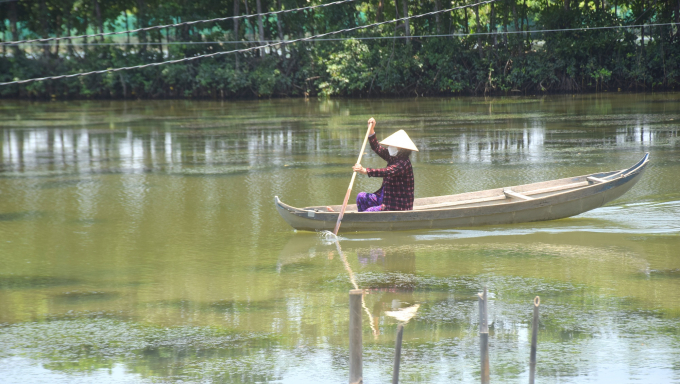
Improved extensive shrimp farming households have no technical investment, so unfavorable weather causes a risk of heavy damage. Photo: V.D.T.
Mr. Tran Minh Tuan, Head of Phu My district Department of Agriculture and Rural Development, said: "As soon as we learned that one household in My Thanh commune contracted the disease, we directed the district Agricultural Service Center to urgently take samples and promptly localize epidemic treatment area. The epidemic is currently under control and experts continue to monitor the situation to support farmers".
“To actively prevent diseases, shrimp farmers should mix digestive enzymes, vitamin C and minerals in food to increase shrimp resistance, help shrimp molt and harden shells quickly. They can also increase aeration of ponds so that oxygen content is provided sufficiently across all water layers, avoiding stratification.
If the weather continues to fluctuate, shrimp farmers should regularly monitor the health of farmed shrimp. When farmed shrimps show signs of abnormality or infection, farmers should immediately report to local authorities and veterinary facilities to localize, handle, and avoid the risk of infection on a larger scale", advised Ms. Nguyen Thi Ngoc Lan.
Translated by Nguyen Hai Long
![Reducing emissions from rice fields: [Part 1] Farming clean rice together](https://t.ex-cdn.com/nongnghiepmoitruong.vn/608w/files/news/2025/05/05/z6509661417740_a647202949c539012a959e841c03e1d3-nongnghiep-143611.jpg)
(VAN) Growing clean rice helps reduce environmental pollution while increasing income, allowing farmers to feel secure in production and remain committed to their fields for the long term.
/2025/05/19/5136-1-144800_230.jpg)
(VAN) The Nghe An Provincial People's Committee has just approved the list of beneficiaries eligible for revenue from the Emission Reductions Payment Agreement (ERPA) in the North Central region for the year 2025.
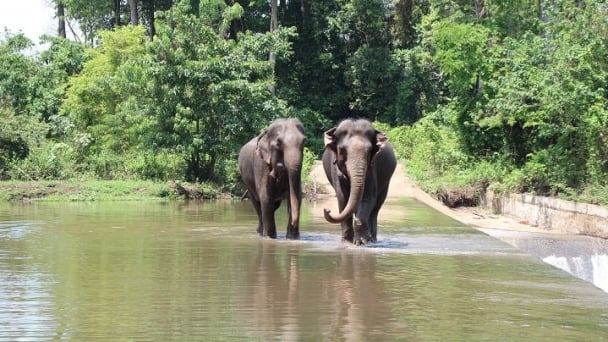
(VAN) 14 out of 35 domesticated elephants in Dak Lak province have had their living conditions improved, with 11 of them currently participating in the non-riding elephant tourism model.

(VAN) Muong Nhe Nature Reserve hopes that being upgraded to a national park will lay the foundation for forest protection efforts to be carried out in a systematic, modern, and sustainable manner.
/2025/05/16/3923-2-171845_52.jpg)
(VAN) Lower costs, higher yields, and improved soil quality are outstanding benefits that soybeans bring when integrated into the crop rotation system.

(VAN) The 'For a Green National Environment' programme aims to promote a green lifestyle, support businesses in implementing ESG practices, and turn Net Zero commitments into concrete actions.
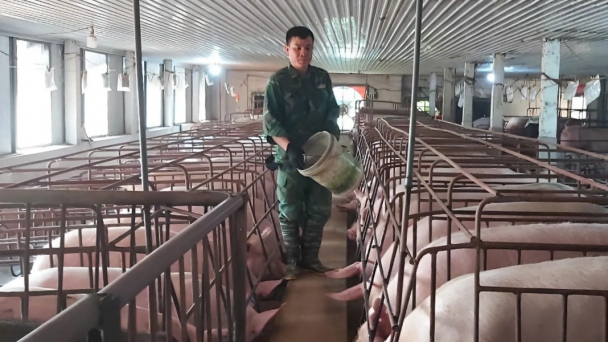
(VAN) Cold-barn systems efficiently manage environmental and temperature conditions, which aids in the prevention of respiratory diseases in pigs and protects them from the vectors that transmit African swine fevers.